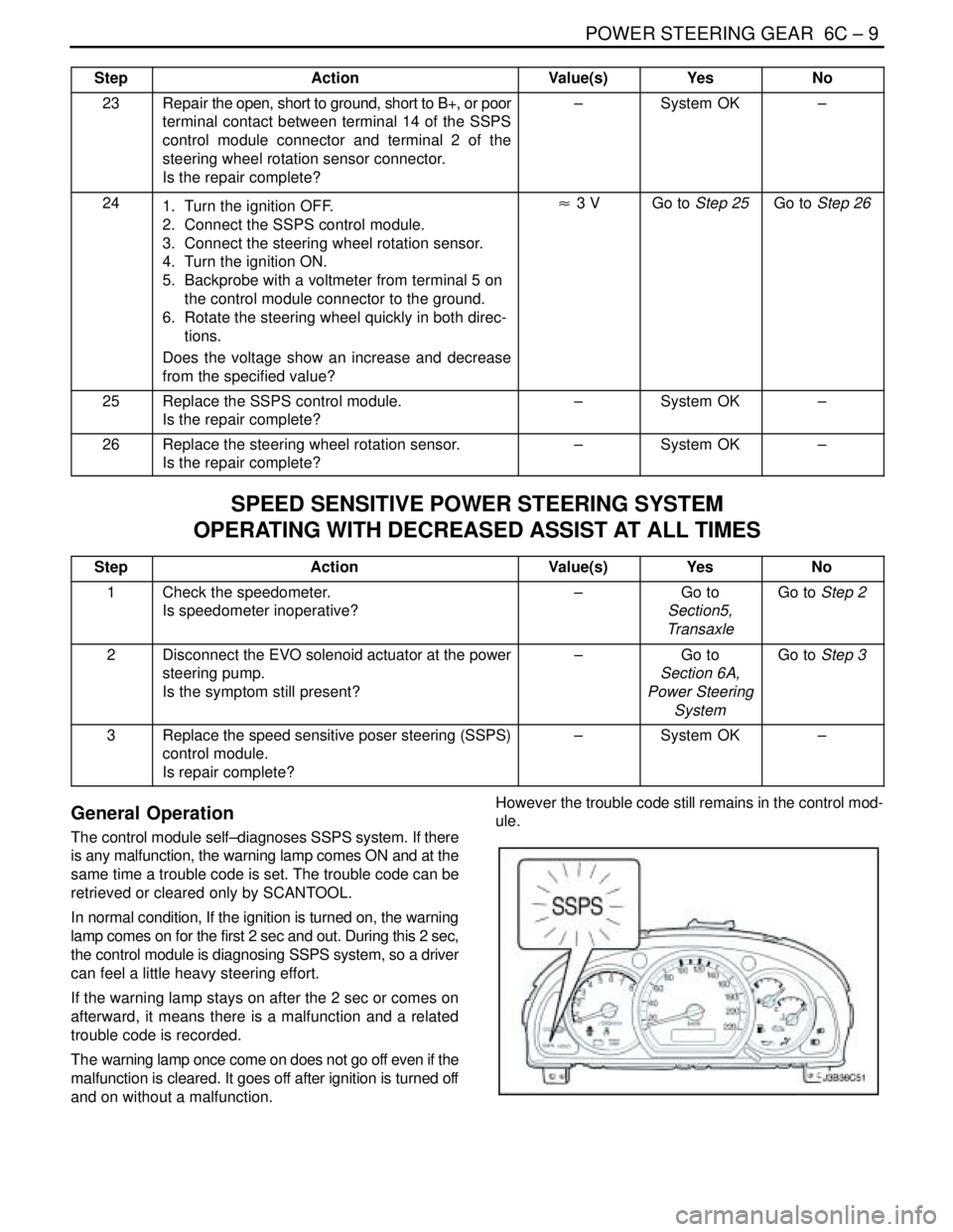Page 1810 of 2643
5A2 – 220IAISIN AUTOMATIC TRANSAXLE
DAEWOO V–121 BL4
Output Shaft Speed (ISS) Sensor
OSS sensor is located on the upper position of the trans-
axle and detects the vehicle speed from the rotation num-
ber of the differential gear.
Shift Control
When the ATF is below specification (15°C), 4th up–shift
is prevented.
Page 1842 of 2643
5B – 18IFIVE–SPEED MANUAL TRANSAXLE
DAEWOO V–121 BL4
GEARSHIFT LEVER HOUSING
(LEFT–HAND DRIVE SHOWN,
RIGHT–HAND DRIVE SIMILAR)
Removal Procedure
1. Disconnect the negative battery cable.
2. Remove the rod clamp. Refer to ”Shift Linkage Ad-
justment” in this section.
3. Remove the console.
4. Remove the gearshift lever housing bolts and the
gearshift lever housing.
Installation Procedure
1. Install the gearshift lever housing and the gearshift
lever housing bolts.
Tighten
Tighten the gearshift housing bolts to 7 NSm ( 62 lb–
in).
2. Adjust the shift linkage.
3. Install the console.
4. Connect the negative battery cable.
SPEEDOMETER DRIVEN GEAR
Removal Procedure
1. Disconnect the speedometer speed sensor electri-
cal connector.
2. Remove the speedometer housing retaining bolt.
3. Remove the speedometer–driven gear and the
speedometer housing.
Page 1843 of 2643
FIVE–SPEED MANUAL TRANSAXLE 5B – 19
DAEWOO V–121 BL4
Installation Procedure
1. Coat the O–ring with petroleum jelly.
2. Install the speedometer–driven gear and the
speedometer housing.
3. Install the speedometer housing retaining bolt.
Tighten
Tighten the speedometer housing retaining bolt to 4
NSm (35 lb–in).
4. Connect the speedometer speed sensor electrical
connector.
SHIFT LINKAGE ASSEMBLY
Removal Procedure
1. Disconnect the negative battery cable.
2. Remove the rod clamp. Refer to ”Shift Linkage Ad-
justment” in this section.
3. Remove the clip and the bolt from universal joint.
4. Separate the universal joint from the transaxle.
5. Remove the fixing shaft pin and separate the link-
age connection part from the transaxle rear mount-
ing bracket.
6. Remove the shift linkage assembly.
Page 1845 of 2643
FIVE–SPEED MANUAL TRANSAXLE 5B – 21
DAEWOO V–121 BL4
TRANSAXLE ASSEMBLY
Tools Required
J–28467–B Engine Support Fixture
Removal Procedure
1. Install the engine support fixture J–28467–B.
2. Remove the battery and battery tray. Refer to Sec-
tion 1E, ENGINE ELETRICAL.
3. Remove the shift linkage assembly. Refer to ”Shift
Linkage Adjustment” in this section.
4. Remove the drive axle shaft. Refer to Section 3B,
Manual Transaxle Drive Axle.
5. Disconnect the backup lamp switch electrical con-
nector.
6. Disconnect the speedometer speed sensor electri-
cal connector.
7. Remove the pin and the clutch release cylinder
pipe.
8. Remove the damping block connection nut and
bolt.
9. Remove the three rear mounting bracket bolts.
10. Remove the rear mounting bracket from the trans-
axle.
Page 1849 of 2643
FIVE–SPEED MANUAL TRANSAXLE 5B – 25
DAEWOO V–121 BL4
11. Connect the clutch release cylinder pipe.
12. Connect the speedometer speed sensor electrical
connector.
13. Connect the backup lamp switch electrical connec-
tor.
14. Remove the engine support fixture J–28467–B.
15. Install the drive axle shaft. Refer to Section 3B,
Manual Transaxle Drive Axle.
16. Install the shift linkage assembly. Refer to ”Shift
Linkage Assembly” in this section.
17. Install the battery and battery tray. Refer to Section
1E, ENGINE ELETRICAL.
18. Inspect the fluid level. Refer to ”Checking Fluid Lev-
el” in this section.
Page 1926 of 2643

POWER STEERING GEAR 6C – 9
DAEWOO V–121 BL4
StepNo Yes Value(s) Action
23Repair the open, short to ground, short to B+, or poor
terminal contact between terminal 14 of the SSPS
control module connector and terminal 2 of the
steering wheel rotation sensor connector.
Is the repair complete?–System OK–
241. Turn the ignition OFF.
2. Connect the SSPS control module.
3. Connect the steering wheel rotation sensor.
4. Turn the ignition ON.
5. Backprobe with a voltmeter from terminal 5 on
the control module connector to the ground.
6. Rotate the steering wheel quickly in both direc-
tions.
Does the voltage show an increase and decrease
from the specified value?� 3 VGo to Step 25Go to Step 26
25Replace the SSPS control module.
Is the repair complete?–System OK–
26Replace the steering wheel rotation sensor.
Is the repair complete?–System OK–
SPEED SENSITIVE POWER STEERING SYSTEM
OPERATING WITH DECREASED ASSIST AT ALL TIMES
StepActionValue(s)YesNo
1Check the speedometer.
Is speedometer inoperative?–Go to
Section5,
TransaxleGo to Step 2
2Disconnect the EVO solenoid actuator at the power
steering pump.
Is the symptom still present?–Go to
Section 6A,
Power Steering
SystemGo to Step 3
3Replace the speed sensitive poser steering (SSPS)
control module.
Is repair complete?–System OK–
General Operation
The control module self–diagnoses SSPS system. If there
is any malfunction, the warning lamp comes ON and at the
same time a trouble code is set. The trouble code can be
retrieved or cleared only by SCANTOOL.
In normal condition, If the ignition is turned on, the warning
lamp comes on for the first 2 sec and out. During this 2 sec,
the control module is diagnosing SSPS system, so a driver
can feel a little heavy steering effort.
If the warning lamp stays on after the 2 sec or comes on
afterward, it means there is a malfunction and a related
trouble code is recorded.
The warning lamp once come on does not go off even if the
malfunction is cleared. It goes off after ignition is turned off
and on without a malfunction.However the trouble code still remains in the control mod-
ule.
Page 1927 of 2643
6C – 10IPOWER STEERING GEAR
DAEWOO V–121 BL4
Trouble Code
DTCTroubleDefault Action
01Actuator circuit open
02Actuator HI to LO short
03Actuator circuit short to B+
04Actuator HI short to GroundWarning lamp ON, Actuator Off
05Actuator LO short to Ground
06Steering Wheel Speed Sensor Open
07Steering Wheel Speed Sensor short to 5V
08Battey Voltage Out of Range (9~16 V)
Page 1950 of 2643

POWER STEERING GEAR 6C – 33
DAEWOO V–121 BL4
GENERAL DESCRIPTION
AND SYSTEM OPERATION
POWER RACK AND PINION
The power rack and pinion steering system has a rotary
control valve that directs hydraulic fluid coming from the
hydraulic pump to one side or the other side of the rack pis-
ton. The integral rack piston is attached to the rack. The
rack piston converts hydraulic pressure to a linear force
that moves the rack left or right. That force is then trans-
mitted through the tie rods to the steering knuckles, which
turn the wheels.
If power rack and pinion steering is not available, manual
rack and pinion control is used; however, with this system,
more steering effort is required. The movement of the
steering wheel is transferred to the pinion. The rotary
movement of the pinion is then transferred through the pin-
ion threads, which mesh with teeth on the rack, thereby
causing the rack to move in a linear direction.
A vane–type of hydraulic pump provides hydraulic pres-
sure for both steering systems.
SPEED SENSITIVE POWER
STEERING SYSTEM
The speed sensitive power steering (SSPS) system varies
the driver effort required to steer as the vehicle speed
changes. At low speeds, the system provides maximum
power assist for easy turning and parking maneuvers. At
higher speeds, the steering power is reduced to provide
the driver with firmer steering and directional stability. The
SSPS system accomplishes this by reducing the amount
of power steering fluid flow from the power steering pump
to the power steering gear as the vehicle speed increases.
When the vehicle is stationary, the SSPS system provides
maximum fluid flow to the steering gear. As the vehicle
speed increases, the fluid flow to the steering gear is de-
creased.
Control Module
The SSPS control module processes the vehicle speed in-
formation from the engine control module (ECM) and uses
the steering wheel rotation sensor to provide a control sig-
nal to the electronic variable orifice (EVO) actuator located
on the power steering pump.
Electronic Variable Orifice (EVO) Actuator
The electronic variable orifice (EVO) actuator is located on
the power steering pump and contains a solenoid– oper-
ated pintle valve. Fluid leaving the pump passes through
an orifice in the actuator tip. When the EVO actuator is
powered by the SSPS control module, the pintle moves
into the orifice and reduces the power steering fluid flow.As the vehicle speed increases, current from the SSPS
control module increases, and the pintle blocks more and
more of the orifice.
Steering Wheel Rotation Sensor
The steering wheel rotation sensor is located at the end of
the steering column housing and is used to send a signal
to the controller when abrupt or evasive steering maneu-
vers are needed.
Power Steering Pressure Hose
SSPS vehicles have a specific pressure hose assembly
which includes an in–line check valve in the rack and pin-
ion assembly. This reduces the amount of steering wheel
”kick” when driving over irregular road surfaces while oper-
ating at speeds with reduced flow rate and pressure.
Power Rack and Pinion
Except for differences in valve machining, the design of
the SSPS power rack and pinion assembly is the same as
for the a non–SSPS system. The steering wheel move-
ment is transferred to the pinion via the intermediate shaft.
The pinion moves the rack left or right through meshing the
pinion and the rack teeth. The force is then transmitted
through the tie rods and steering knuckle to steer the
wheels.
The power rack and pinion steering system has a rotary
control valve which directs the hydraulic fluid from the
power steering pump to one side or the other side of the
rack piston. The piston is attached to the rack and uses hy-
draulic pressure to move the rack left or right. The rotary
control valve regulates the degree of assist by responding
to the driver’s torque input.
If hydraulic assist is not available, manual control is main-
tained. However, under this condition, more steering effort
is required.
Power Steering Pump
The standard vane–type pump, which provides hydraulic
pressure for the system, incorporates a special discharge
fitting to hold the EVO actuator.
System Operation
System operation originates with input from the vehicle
speed sensor via the engine control module to the SSPS
control module. The SSPS control module sends a signal
to the SSPS actuator to vary the rate of fluid flow output
by the power steering pump.
Circuit Operation
The SSPS system uses inputs from the speed sensor and
steering wheel rotation sensor to the SSPS controller to
determine the desired amount of power steering assist.
The SSPS control module constantly compares the
amount of current flowing through the EVO actuator to the
desired current it has calculated. The EVO actuator has a
pintle that moves in and out of an orifice, regulating power